Started off with 1˝ days of lazing at our hotel – except for Lene's extensive hunt for designer bags on Jalan Seminyak in the northern part of Kuta. Otherwise we did nothing much except read and relax.
There are basically three main hotel areas in the South of Bali: Kuta with lots of clubs, restaurants and shops and a beach perfect for surfing; Sanur, which is a bit more exclusive with better hotels, some snorkelling and calm waters; and Nusa Dua with its calm atmosphere perfect for relaxing.
Temples galore
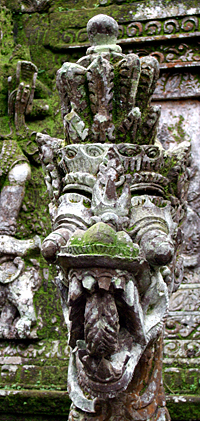 Most
of Indonesia's Hindus live on Bali. Here some 93% of a population of 3,5 mio.
adhere to Balinese Hinduism. Every single one of Bali's 700 villages has at
least three temples devoted to Brahma, Vishnu and Shiva – and every family
has its own little shrine indoors. It's understandable that Bali is also
called Island of the Gods.
Most
of Indonesia's Hindus live on Bali. Here some 93% of a population of 3,5 mio.
adhere to Balinese Hinduism. Every single one of Bali's 700 villages has at
least three temples devoted to Brahma, Vishnu and Shiva – and every family
has its own little shrine indoors. It's understandable that Bali is also
called Island of the Gods. Hinduism on Bali is a combination of local beliefs and heritage influenced by mainly India. It even includes references to Buddhism and animism. Everywhere you'll see the Canang – a small, square basket made from the leaves of the coconut palm. Inside is for example a slice of banana or a sugar cane, a couple of rice grains, colourful flowers and some torn leaves on top.
Canang is the most common form of offering and together with incense and holy water it is placed in temples, by shrines or other everyday places like shops to keep angry or evil spirits out and to greet the good ones.
In the Balance
Before we started our tour of Bali we stopped at Badubulan to witness the Barong Kris Dance. The most famous of all Balinese dances about the battle between the good and the bad. As usual no-one wins as the most important lesson is balance. We were treated to an abbreviated tourist-friendly version that lasted only an hour compared to the normal 2˝ hours when performed in the temples.
The Justice Court
One of the most interesting sites is the old royal justice court Kertegosa in Klungkung, which functioned as Bali's supreme court. When all else failed the case was brought before three Brahmana priests here who actually had a reputation of being very harsh and unjust in their rulings. The ceiling of the court is filled
 with
very graphic descriptions of various forms of punishment. The origins of the
palace date back to 17th century but today only the court and the floating
pavilion are still standing.
with
very graphic descriptions of various forms of punishment. The origins of the
palace date back to 17th century but today only the court and the floating
pavilion are still standing.The reign of Klungkung came to an end in 1908 when the Balinese of Klungkung decided to make one last stand against the Dutch in the form of a so-called puputan – a mass ritual suicide that left all dead including women and children.
The Mother Temple
On the slopes of Mt. Agung at about 1,000 m lies Bali's largest and most holy temple complex, Puri Besakih, a total of 17 temples devoted to Brahma, Visnu and Shiva as well as the Hindu caste system. It is necessary to park some distance away and to walk the gauntlet along an alley filled with souvenir shops.
The oldest parts of the complex dates back to the 9th century, and as the preferred building material was limestone many smaller features have withered away. Unfortunately, part of the restoration is made by covering the original limestone bricks with blocks of black lava stones.
Road Work
The drive down the slopes of Mt. Agung was absolutely astonishing: Small, twisted, steep and narrow roads through a beautiful landscape.
We had our lunch (as most tourists, I suspect) at Lereng Agung in Redang with an astonishing view of a valley full of rice paddies and people and buffaloes the size of ants at the bottom.
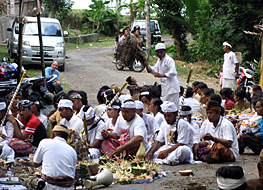
When we drove through the small village of Budung we had to pull over as the locals were conducting a burial ritual in the middle of the road. But we arrived at our nice little hotel in Candidasa just in time for dinner.
The Eternal Rains of Mt. Agung
Candidasa is a cosy little town on the East coast in the shade of Mt. Agung. It rains like clockwork early every morning, and the lands are extremely fertile.
After breakfast we ventured back on the Southern slopes of the volcano and visited a.o. the Kehen-temple, Bali's second largest and very beautiful. We also stopped at Bas in Seribatu at a ”factory outlet” for nearby spice, coffee and tea plantations.
In the Kintamani highlands we drove along the caldera of Mt. Batur for quite a while and had a magnificent view of the three craters and the lake. The latest eruption occurred in 1990 but in the 1920's quite a violent one vomited so much black lava that it's still being quarried today and used for houses, sculptures and temple restorations.
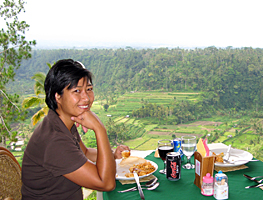
The Black Sands of Lovina
Through Beji with its baroque rice farmer's temple and onwards to Lovina on the North coast. Lovina is not actually a location but rather a fictional term invented by an American journalist who stayed at the North coast at some point in the early 80's.
Lovina stands for Love Indonesia. He did have a specific location in mind but the term spread quickly so now almost every hotel at a stretch of seven or eight villages is situated ”at Lovina”.
We arrived at the Bali Taman in Singaraja late afternoon – just in time for a look around. The pitch-black lava sand beach was almost deserted, a fleet of bankas lay idly out of the water, and a couple of tourists had a go at snorkelling .
The Wimp that Sent Us Diving
At the pool a father was trying to learn his kid how to snorkel. But the kid failed at even the most basic stuff – like getting in the water for one thing. But the kid's wimping and the crying and the spineless father made us contemplate whether we really, really wanted to spend the following day here – in their company. I raced down to the reception, found a poster from Baruna Divers, made a call, and immediately felt much better.
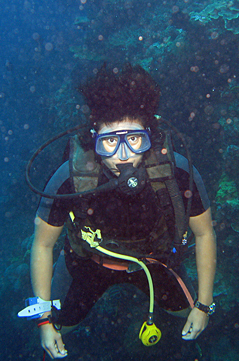
The Box
It took about an hour to go from Singaraja to Kelompang Bay on the Westernmost tip of Bali. And another 25 minutes to get to Mejangan Island on board one of the local narrow longboats. Edwin was the name of our guide for the day, and he quickly fell into our pace of things: More than two fin kicks per minute constitute escape.
Our first dive was at The Box: A very nice slope down to some 25 metres filled with colourful sponges, fans and soft corals. Most of the dive we all had our noses to the ground in search of tiny critters and the inconspicuous pygmy seahorse but... alas. Second dive was on the wall at Bat Cave full of nice caverns and holes. Thank you, wimp!
Famous Waterfalls and Monkeys
On our way back across central Bali we passed the Gitgit Waterfall. It is hyped a great deal as being both dramatic and lush but in reality quite disappointing. Its significance wasn't clear until we discovered that at one point two streams become one, which is campuhan in Hindu and very important.
Over the ridge at about 1,400 metres we had a smooth drive down to Pancasari at Tao Buyan. And the pleasurable company of a great many monkeys that didn't have a go at our sunglasses and hats. Very cute.
Bone Back No. 32
We happened to come across yet another burial ceremony in the village of Bedugul. However, this was of quite a different nature than we'd seen before. The main street was crammed with people all dressed up, most of them carrying plates and baskets with food. In the middle of street a big contraption had been erected and people kept carrying small, white bags up a ladder and stacking them next to each other.

We arrived just as the first bag was being placed. It turned out that there was a mass cremation going on of all the people that had passed away in the last two years. The bones of one person in one bag, a total of 52 people according to those we asked. But by bag no. 32 we had no choice but to leave. Next they would drag the contraption down to the cemetery, distribute each bag to its own bonfire and set it alight. Unfortunately, that would last another five to six hours.
The Rock in the Ocean
Trust a devout disciple to build a place of worship in the most impossible place. Like Pura Tanah Lot, the Temple on the Rock in the Ocean. A somewhat alternative location in the sea only accessible at low tide. Some local fishermen had
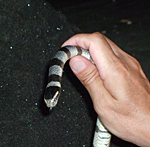 caught three two-banded sea snakes, put them in a hole in the
rock and demanded 1,000 Rupiah per person to see the holy snakes.
What the heck! I actually held a two-banded sea snake between my fingers. Yihaa!!
caught three two-banded sea snakes, put them in a hole in the
rock and demanded 1,000 Rupiah per person to see the holy snakes.
What the heck! I actually held a two-banded sea snake between my fingers. Yihaa!!Bali's Cultural Centre
Ubud is considered to be Bali's cultural centre but, honestly, what we saw in terms of paintings and silver and gold works were no match to what we had seen in Yogjakarta. We took a stroll along the main street Jalan Raya Ubud in the evening, and the next day we visited a gallery on the outskirts of Ubud. Here we were shown various techniques and styles and it was easy to recognize the styles of great European painters like Picasso, Cezanne and Monet – only Bali style.
The Last Night
The last night on our journey was spent at the lovely Grand Mirage in Tanjung Benoa, the northern part of Nusa Dua. Our room wasn't ready when we arrived so we were upgraded to a suite larger than our apartment at home. We had a magnificent view of the bay and plenty of room to repack our luggage amidst sipping ginger beer and Bintang.
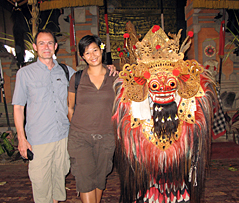
We were on the Indonesian roads for a whole month and were treated to exquisite experiences almost every where we went. From standing face to face with orang-utans in the West and with Komodo dragons in the East to everything in between. It had been an amazing journey in an amazing country. And there are still plenty of adventures to be had here.
We'll be back... :-)
